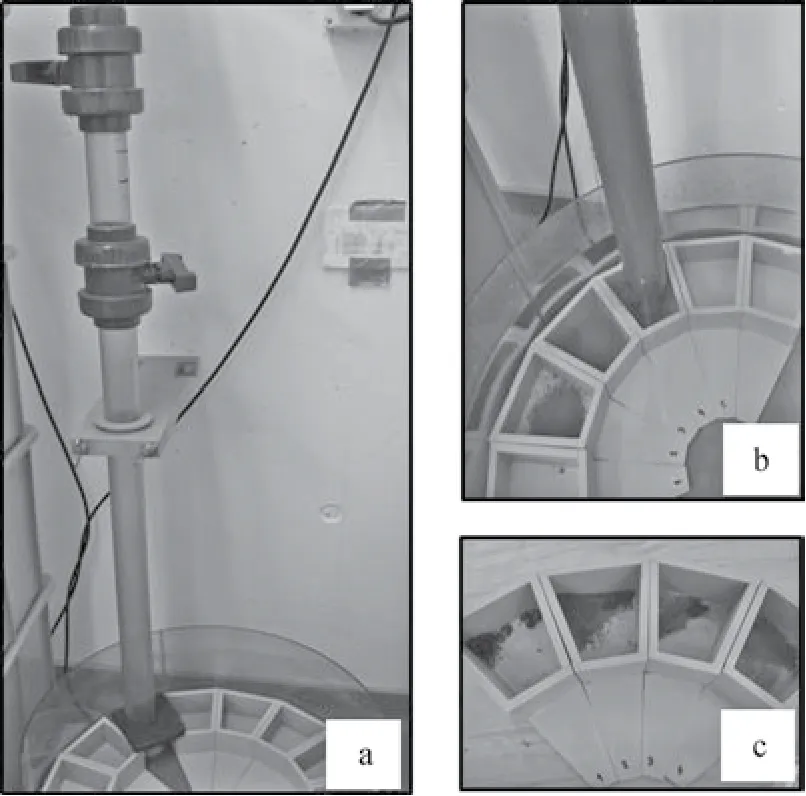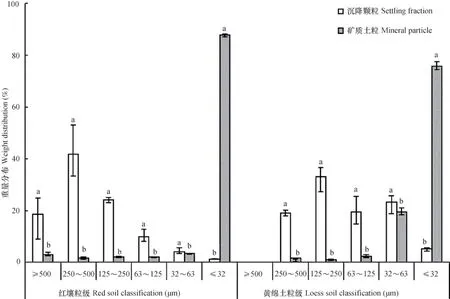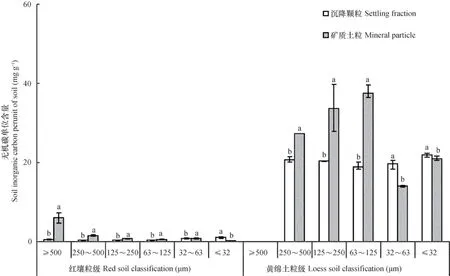利用土壤颗粒的沉降粒级研究泥沙的迁移与分布规律*
2017-11-01胡亚鲜NikolausKuhn
胡亚鲜 Nikolaus J. Kuhn
(1 西北农林科技大学水土保持研究所,陕西杨凌 712100)
(2 中国科学院水利部水土保持研究所黄土高原土壤侵蚀与旱地农业国家重点实验室,陕西杨凌 712100)
(3 瑞士巴塞尔大学环境科学系,巴塞尔 4056 瑞士)
利用土壤颗粒的沉降粒级研究泥沙的迁移与分布规律*
胡亚鲜1,2Nikolaus J. Kuhn3
(1 西北农林科技大学水土保持研究所,陕西杨凌 712100)
(2 中国科学院水利部水土保持研究所黄土高原土壤侵蚀与旱地农业国家重点实验室,陕西杨凌 712100)
(3 瑞士巴塞尔大学环境科学系,巴塞尔 4056 瑞士)
了解不同粒径泥沙迁移运动规律,有助于深入理解侵蚀条件下碳、氮、磷等元素的生物地球化学过程。土壤营养元素的迁移转化与泥沙颗粒的运动规律密切相关,而泥沙的运动规律由颗粒大小、性状、孔隙度和密度等因素共同决定。依据泥沙颗粒沉降速度分选的原理,针对中国两种典型侵蚀土壤(红壤和黄绵土),分别进行了土壤机械组成(矿质土粒分选)和沉降速度分选测定。结果表明,土壤颗粒的沉降粒级可有效区分红壤和黄绵土中不同粒径团聚体的沉降速度,能够更加准确地反映出同一粒径颗粒因性状、密度和孔隙度的差异而形成的不同沉降速度。相对于质地疏松的黄绵土,红壤的机械组成显示,有86.9%的有机碳与≤32 μm的矿物颗粒相结合,很有可能随悬移过程汇入下游水体。但土壤颗粒沉降速度分布表明,约有90.5%的红壤有机碳与等效石英粒径≥63 μm的团聚体相结合,易在经历较短的迁移过程后,快速沉积于下坡面。这表明,现有的土壤侵蚀模型大多利用土壤机械组成(即矿质粒径大小)在反映泥沙运动或元素迁移规律方面存在片面性。土壤的团聚过程可有效缩减有机碳和无机碳的迁移距离,从而使其更易沉积于陆生环境。土壤颗粒的沉降速度分级对认识泥沙颗粒和养分元素在侵蚀—迁移—沉积过程中的生物地球化学过程提供了新的途径和视角。
沉降管法;沉降速度;团聚体;迁移距离;有机碳;无机碳
土壤的侵蚀和迁移过程决定泥沙中元素的空间分布,而沉积区的微环境影响了泥沙中有机碳的生物地球化学转化过程,从而对土壤有机碳总储量、大气中CO2的循环以及下游河流系统中元素的富集产生深远的影响[1-3]。了解泥沙颗粒的运动规律是研究泥沙中养分元素(如有机碳或磷)在流域内的空间分布及生物地球化学特征的基础[4-6]。泥沙的运动规律由颗粒大小、性状、孔隙度和密度等因素共同决定[7-9]。然而,现今土壤侵蚀模型中,泥沙的沉降速度主要依赖于土壤矿质土粒或机械组成,即通过粒径大小来估算,在反映泥沙运动规律方面存在片面性[10-13]。事实上,泥沙在侵蚀和迁移的过程中主要是以团聚体形式运动,而非矿质单粒形式[14-16]。团聚过程可将沉降速度慢的细小颗粒团聚成沉降速度较快的大颗粒,从而缩减其迁移距离。因此,相对于矿质土粒或机械组成,土壤团聚体的沉降速度能够更加准确地反映泥沙的侵蚀和迁移过程[17]。然而,传统的土壤团聚体分选方法,如湿筛和干筛[18-19],除了依赖粒径分级的片面性之外,在筛选过程中,团聚体也易因摩擦而破裂,造成大颗粒团聚体含量的减损,无法充分反映土壤团聚体的颗粒组成[20]。因此,水土流失过程中泥沙颗粒的理想分选方法,不仅需实现团聚体沉降速度分选,还应保持不同粒级团聚体的完整性。
1 材料与方法
1.1 供试土壤
本研究选用两种典型侵蚀土壤,红壤(简育湿润富铁土,Hapli-Udic Ferrosols)和黄绵土(黄土正常新成土,Loessi-OrthicPrimosols),分别采集于江西南昌典型旱作坡耕地和黄土高原陕西省长武县王东沟典型坡地。此两种供试土壤质地相似,但其有机碳含量与团聚体结构差异甚大,可对比反映不同团聚结构对土壤颗粒运动规律的影响。相关土壤性状见表1。本研究将两种土壤分别进行两种不同方法的分级——传统机械(矿质土粒)组成法和沉降管法,对比分析两种方法下土壤颗粒的差异性分布。

表1 供试土壤基本理化性质Table 1 Physio-chemical properties of the red soil and loess soil
1.2 土壤颗粒的矿质粒径分选
称取25 g风干土,浸入水中,配成总体积为100 ml的悬浊液。用超声震荡仪(Sonifer 250,Branson,美国)将此悬浮液以总能量为60 J ml-1的强度进行充分震荡(总能量 = 震荡仪输出功率70 W ×震荡时长85 s / 悬浊液总体积100 ml)。在震荡过程中,注意通过水浴或者冰浴控制悬浊液的温度变动小于5℃,防止震荡能量因温度变化而带来的误差。随后,将震荡后的悬浊液进行湿筛,并将其分选为六个矿质粒径级别:≥500 μm、250~500 μm、125~250 μm、63~125 μm、32~63 μm、≤32 μm。分选后,晾干,称重,并用总碳分析仪(Leco RC 612,St. Joseph,美国)测定各级别的有机碳和无机碳含量。试验重复三次。
1.3 土壤颗粒的沉降速度分选
称取25 g风干土,浸泡于50 ml水中,静置15 min。土壤遇水后发生一定程度的团聚体破裂现象,此静置过程可有效保证团聚体破裂程度的统一性,降低重复样本之间的误差。随后,将该悬浮液样品从沉降管顶部注入,根据不同团聚体颗粒的沉降速度,按特定时间间隔,进行分选。进行沉降速度分级实验时,先使用投放器,将土壤样品由沉降管顶部投放至沉降管水体中,旋转水槽,依据斯托克斯定率(Stokes’Law)所计算出的不同颗粒的沉降时间,将收集器对准沉降管底端,实现对土壤样品按照沉降速度进行分选收集。该方法不仅避免干筛或湿筛方法带来的团聚体破坏,而且可最大限度地反映团聚过程对细小颗粒沉降时间的加速现象,从而更真实地推算团聚体的最大迁移距离,有效减小了单一依据矿质土粒分析而带来的输沙量估算方面的误差。
具体而言,沉降管法主要通过速度沉降管设备实现,其主要由三部分组成(图1):(1)沉降管,用于土壤样品自上而下沉降运动;(2)样品投放器,用于将土壤样品从沉降管顶端投入管内;(3)旋转水槽,按照特定时间间隔旋转,分级收集从沉降管底部沉降出的土壤颗粒。
沉降管:本实验所用沉降管根据图1所示设计,由透明聚氯乙烯(PVC)管所制,高80 cm,内径5 cm,总容积约为1.57 L(图1a)。进行土壤沉降速度分级的过程中,沉降管应始终充满水,形成直立水柱用于土壤颗粒自上而下进行沉降。多数情况下,土壤颗粒小于2 mm,因此,沉降管内径(50 mm)与土壤颗粒(2 mm)的比值大于25∶1,可有效避免边界效应(< 10%)[17]。与吸管法相比,此沉降管主要有三点不同:(1)沉降管长度较长,可保证快速沉降的大颗粒团聚体能够充分沉降,并在沉降管内实现有效分选;(2)沉降管直径较大,可承载较大容积的混合液,有效避免各个颗粒之间的推挤或抱团现象,保证不规则形状团聚体的顺利沉降;(3)沉降管底端开口开阔,土壤颗粒可无阻碍排出,有效避免因细小出口所带来的土壤颗粒堆积或者团聚体破裂现象。因此,与吸管法相比,沉降管法以更长沉降距离,更宽裕的管内径,以及更开阔平顺的底端开口,更适用于研究田间尺度泥沙的运动规律。
样品投放器:用于将土壤样品从顶端投至沉降管中,它主要有两种样式:推杆型(如Hu等[21]中所述)和阀门型(图1a)。推杆型投放器是由一个约30 cm长的推杆穿过一个中空的容器,上下推送,实现样品投放。该推送杆两端分别配有可拆卸橡皮塞,用于密闭,实现沉降管内水柱直立不掉落。阀门型投放器是由两个球形阀门与一个中空短管组成,通过先后控制球形阀门的开合,实现空间密闭和样品投放。在投放土壤样品之前,投放器容积约为80 cm3,约可容纳土壤样品25 g(干重),悬浮液浓度约为6 g L-1。根据Loch[17]的报告,此悬浮液浓度并不会对土壤颗粒的沉降运动造成干扰。若所需沉降分选样品为径流场或者流域内收集的泥沙,也可直接将泥沙鲜样从沉降管顶部注入,实现泥沙鲜样的实时沉降与分选,用于反映泥沙不同颗粒在径流条件下的沉降速度,并推测其迁移距离分布。
旋转水槽:放置于沉降管下端(图1b),用于收集从沉降管底部沉降出的土壤颗粒。旋转水槽主要由圆形水槽和收集器组成。旋转水槽直径约50 cm、深20 cm,容积约为40 L;水槽内放置小型样品收集器若干,每个收集器容积约为290 cm3,并使初始收集器对准沉降管底部。土壤颗粒抵达沉降管底部之后,便可进入样品收集器。经过指定时间后,便可转动水槽,使下一个收集器对准沉降管底部,继续收集下个速度级别的土壤颗粒。在土壤样品沉降过程中,水槽内的水深必须没过沉降管底部,与沉降管内的水柱形成一体,从而防止沉降管中的水柱掉落。若有条件,可在旋转水槽底部设置电动马达,与延时继电器相连,准确控制水槽旋转的时间点和间隔,实现土壤颗粒按照不同沉降速度进行分选(图1c)。若条件有限,也可手动旋转水槽,但必须均匀轻柔,防止因过快旋转造成水槽内水体波动所带来的土壤颗粒漂移。

图1 沉降速度管设备(a.设备整体构造,b.样品分选过程,c.分选后颗粒)Fig. 1 The settling tube apparatus(a. the complete apparatus setting,b. settling fractionation,c. soil particles after fractionation)
1.4 颗粒沉降时间间隔计算
根据斯托克斯定律,土壤颗粒在水体中的沉降速度可由以下公式计算:

式中,V为沉降速度,m s-1;h为沉降距离(即沉降管长度+投放器内悬浮液高度),m,;t为沉降时间,s;d为土壤粒径,mm;g为重力加速度,约为9.81 N kg-1;η为20℃时的水体黏度,约为1×10-3Ns m-2;Ds为土壤颗粒平均密度,约为2.65 ×103kg m-3;Df为水体密度,约为1.0 × 103kg m-3。理论上,斯托克斯定律多用于计算粒径小于0.07 mm颗粒的运动规律[22],因此,对于与本实验供试土壤质地差异较大的其他土壤,可视具体情况,选取相应计算公式[22-23]。
为与传统机械(矿质土粒)组成法进行对比,并方便与现有土壤侵蚀模型中的沉降速度参数结合,本文特利用“等效石英粒径”这一概念,表达与某一石英粒径具有相同沉降速度的土壤团聚体的粒径[17,21]。具体而言,依据斯托克斯定律,将土壤团聚体的以下6组“等效石英粒径”:≥ 500 μm、250~500 μm、125~250 μm、63~125 μm、32~63 μm、≤32 μm,转化为不同沉降时间(表2)。经过868 s沉降后,最细小颗粒,即等效石英粒径≤32 μm的颗粒,仍以悬浮液状态滞留于沉降管中。可将其放出,静置,晾晒,收集,计为等效石英粒径≤32 μm颗粒。利用总碳分析仪(Leco RC 612,St. Joseph,美国)测定不同粒径中有机碳、无机碳以及总碳含量。试验重复三次。若土壤样品的团聚结构与本实验中所选土壤差异较大,可根据需要调整时间间隔(二次分割,或者合并),充分反应目标样品的团聚体沉降速度特征。

表2 土壤颗粒沉降速度、沉降时间和泥沙空间分布Table 2 Settling velocities,times,and likely spatial distribution of soil particles based on equivalent quartz size classes
1.5 数据处理
本文所有数据分析由Microsoft Office Excel 2010完成,文中显著性差异分析由SPSS 21完成,用最小显著差异法(LSD)进行均值间显著性检验,显著性水平取0.05。
2 结果与讨论
2.1 土壤颗粒的沉降速度分布与机械组成分布的差异
通过两种不同的分选方法所得土壤颗粒的分布状况如图2。结果表明,机械(矿质土粒)组成法所得颗粒分布中细颗粒偏多(如,红壤中≤32μm的细颗粒占87.8%),而利用沉降管所得大颗粒较多(如,红壤中≥63 μm的大颗粒占94.5%)。这主要是因为,传统的机械(矿质土粒)组成法破坏了土壤中的团聚体,而沉降管法最大限度地保存了土壤团聚体的原有结构。若按照传统侵蚀模型,利用土壤机械组成对泥沙的空间分布进行预测,那么,红壤中粒径≤32 μm的细颗粒(87.8%)将很有可能随悬移经历较久的迁移过程,甚至很有可能汇入下游水体。然而,实际上,红壤通过团聚过程将细小黏粒或沙粒形成较大团聚体,加速其沉降速度,从而缩短迁移距离。若根据团聚体沉降速度分布,该红壤中94.5%的土壤颗粒实际为等效石英粒径≥63 μm的团聚体,很有可能最终将随团聚体沉积于陆地表面。此种现象,在团聚体结构较弱的黄绵土中也有体现,仅是程度较弱:75.8%的黄绵土为机械组分≤32 μm的细小颗粒,依传统侵蚀模型预测,将很有可能汇入下游水体;但根据团聚体实际沉降速度分布,其71.6%的土壤颗粒实际为等效石英粒径≥63 μm的团聚体,很有可能在经历较近的迁移距离后沉积。这一结果表明,现有土壤侵蚀模型中,依据土壤机械组成(即矿质粒径大小)而推算的泥沙空间假设是不正确的。

图2 红壤与黄绵土沉降速度分选与机械(矿质土粒)组成法的粒级分布Fig. 2 Comparison of weight distribution in red soil and loess soil fractionated by settling and dispersion
2.2 有机碳随团聚体沉降速度的差异性分布
有机碳单位含量(图3)在红壤的各机械粒级和各沉降粒级之间尽管存在显著性差异,但其均值在数量级上差异不大(≤32 μm组除外)。然而,将有机碳单位含量(图3)与各自粒径的重量(图2)相乘之后,有机碳总量分布在两种不同分选方法间则存在明显差异(图4)。尽管,其机械(矿质土粒)组成法所得有机碳分布情况表明,86.9%的有机碳是与红壤中≤32 μm的细小颗粒相结合,很有可能随悬移过程汇入下游水体,从而被掩埋保护,减缓矿化分解过程[26-27]。但土壤颗粒沉降速度分布却显示,约有90.5%的红壤有机碳与等效石英粒径≥63 μm的团聚体相结合(图4),在经历较短的迁移过程后,快速沉积于下坡面。此部分团聚体,快速沉积后,将在后续的降雨和侵蚀事件中,反复经历侵蚀—迁移—沉积过程,并伴随着团聚体破裂和矿化过程[28-29]。此结果与Hu等[21]观察到的规律相似。黄绵土有机碳单位含量在不同矿质颗粒中分布明显高于团聚体沉降颗粒(图3),这主要是因为黄绵土的结构差,超生震荡后破裂程度比红壤更彻底,其有机碳在测定过程中的氧化程度更高。
2.3 无机碳随团聚体沉降速度的差异性分布

图3 有机碳单位含量在红壤和黄绵土不同沉降速度和矿质粒级中的分布Fig. 3 Comparison of the organic carbon content per unit in red soil and the loess soil fractionated by settling and dispersion

图4 有机碳总量在红壤和黄绵土不同沉降速度和矿质粒级中的分布Fig. 4 Comparison of total organic carbon in red soil and the loess soil fractionated by settling and dispersion

图5 无机碳单位含量在红壤和黄绵土不同沉降速度和矿质粒级中的分布Fig. 5 Comparison of the inorganic carbon content per unit of soil in red soil and the loess soil fractionated by settling and dispersion

图6 无机碳总量在红壤和黄绵土不同沉降速度和矿质粒级中的分布Fig. 6 Comparison of the total inorganic carbon in red soil and the loess soil fractionated by settling and dispersion
红壤中无机碳单位含量普遍较小(图5),尽管在不同粒级间存在显著性差异,但其均值在数量级上差值不大。此外,黄绵土中的无机碳单位含量明显高于红壤,且在团聚体沉降速度粒级与机械组成粒级之间也存在较大差异。在将无机碳单位含量(图5)与各自粒径的重量(图2)相乘之后,无机碳总量分布的差异性表现则较为明显(图6):尽管其机械组份表明,77.9%的无机碳是与黄绵土中≤32 μm的细小颗粒相结合,但其实约有59.1%的黄绵土无机碳存在于等效石英粒径≥63 μm的团聚体中。这也表明,黄绵土中无机碳与不同团聚体粒径的结合,也直接影响了其在黄土高原不同流域的空间分布。特别是在土壤pH适宜的条件下,土壤无机碳含量与水热之间的关系,也将会影响土壤中有机碳的固存和矿化过程[30]。这就意味着,随着不同颗粒在不同地点的富集或减损,与其结合的有机碳和无机碳所处的微环境也随之改变,从而影响整个流域内有机碳和无机碳的生物地球化学变化[31-33]。
3 结 论
相较于传统方法仅依赖于土壤机械组成(矿质粒径大小)所进行的测算,此沉降管法用团聚体沉降速度进行分级,能更加全面地反映泥沙运动规律,明确泥沙颗粒的迁移距离和空间分布特征,从而准确了解营养物质的迁移转化过程,为深入理解土壤侵蚀—迁移—沉积全过程对有机碳循环的影响提供理论依据。本研究还证实了团聚过程可将沉降速度较慢的细小黏粒或沙粒汇聚成沉降速度较快的较大团聚体,从而加速了细小颗粒的沉降速度,缩短其迁移距离。这也就意味着,那些原本经悬移运动至下游水体的细小颗粒,由于团聚过程的加速效应,将随较大的团聚体沉积于坡脚附近,从而改变了现有侵蚀模型中对于泥沙空间分布的假定。由于沉降管法是利用泥沙颗粒的沉降速度来反映其运动规律,无其他限制条件,因此,可适用于分析不同类型土壤在不同侵蚀程度下的泥沙运动规律,对重新认识养分元素在侵蚀—迁移—沉积过程中的生物地球化学过程提供了新的视角。
致 谢感谢瑞士巴塞尔大学实验员Ruth Strunk在实验操作方面给予的指导与帮助,感谢中国科学院水土保持研究所郭胜利研究员和西北农林科技大学资环学院博士研究生王蕊在论文整理与修改期间的帮助与支持。
[1] Lal R,Pimentel D. Soil erosion:A carbon sink or source? Science,2008,319(5866):1040—1042
[2] Billings S A,Buddemeier R W,Richter DdeB,et al.A simple method for estimating the influence of eroding soil profiles on atmospheric CO2. Global Biogeochemical Cycles,2010,24(2):GB2001
[3] 肖海兵,李忠武,聂小东,等. 南方红壤丘陵区土壤侵蚀-沉积作用对土壤酶活性的影响. 土壤学报,2016,53(4): 881—890 Xiao H B,Li Z W,Nie X D,et al. Effects of soil erosion and deposition on soil enzyme activity in hilly red soil regions of South China(In Chinese). Acta Pedologica Sinica,2016,53(4):881—890
[4] 汤珊珊,李鹏,任宗萍,等. 模拟降雨下覆沙坡面侵蚀颗粒特征研究. 土壤学报,2016,53(1):39—47 Tang SS,Li P,Ren Z P,et al. Particle size composition of sediment from sand-covered slope under simulated rainfall(In Chinese). Acta Pedologica Sinica,2016,53(1):39—47
[5] 朱高文,文博,李静,等. 不同雨强和覆盖度条件下崩积体侵蚀泥沙颗粒特征. 土壤学报,2016,53(6):1371—1379 Zhu G W,Wen B,Li J,et al. Particle size composition of erosion sediment from colluvial deposits of collapsing hill as affected by rainfall intensity and coverage(In Chinese). Acta Pedologica Sinica,2016,53(6):1371—1379
[6] 张辉,李鹏,鲁克新,等. 冻融作用对坡面侵蚀及泥沙颗粒分选的影响. 土壤学报,2017,54(4):836—843 Zhang H,Li P,Lu K X,et al. Effects of freezing and thawing on soil erosion and sediment particle size fractionation(In Chinese). Acta Pedologica Sinica,2017,54(4):836—843
[7] Dietrich W E. Settling velocity of natural particles.Water Resources Research,1982,18(6):1615—1626
[8] Kinnell P I A. Particle travel distances and bed and sediment compositions associated with rain-impacted flows. Earth Surface Processes and Landforms,2001,26(7):749—758
[9] Kinnell P IA. Raindrop impact induced erosion processes and prediction:Areview. Hydrological Processes,2005,19(14):2815—2844
[10] Morgan R P C,Quinton J N,Smith R E,et al.The European Soil Erosion Model(EUROSEM):Adynamic approach for predicting sediment transport from fields and small catchments. Earth Surface Processes and Landforms,1998,23(6):527—544
[11] Beuselinck L,Govers G,Steegen A,et al. Evaluation of the simple settling theory for predicting sediment deposition by overland flow. Earth Surface Processes and Landforms,1999,24(11):993—1007
[12] van Oost K,Beuselinck L,Hairsine P B,et al.Spatial evaluation of a multi-class sediment transport and deposition model. Earth Surface Processes and Landforms,2004,29(8):1027—1044
[13] Aksoy H,Kavvas M L. A review of hillslope and watershed scale erosion and sediment transport models.Catena,2005,64(2/3):247—271
[14] Walling D E. Erosion and sediment yield research—some recent perspectives. Journal of Hydrology,1988,100(1/3):113—141
[15] Slattery M C,Burt T P. Particle size characteristics of suspended sediment in hillslope runoff and stream flow.Earth Surface Processes and Landforms,1997,22(8):705—719
[16] Beuselinck L,Steegen A,Govers G,et al.Characteristics of sediment deposits formed by intense rainfall events in small catchments in the Belgian Loam Belt. Geomorphology,2000,32(1/2):69—82
[17] Loch R J. Settling velocity–a new approach to assessing soil and sediment properties. Computers and Electronics in Agriculture,2001,31(3):305—316
[18] Cambardella C A,Elliott E T. Carbon and nitrogen dynamics of soil organic matter fractions from cultivated grassland soils. Soil Science Society of America Journal,1994,58(1):123—130
[19] Christensen B T. Physical fractionation of soil and structural and functional complexity in organic matter turnover. European Journal of Soil Science,2001,52(3):345—353
[20] Xiao L,Hu Y,Greenwood P,et al. The use of a raindrop aggregate destruction device to evaluate sediment and soil organic carbon transport. Geographica Helvetica,2015,70(2):167—174
[21] Hu Y,Fister W,Rüegg H-R,et al. The ue of equivalent quartz size and settling tube apparatus to fractionate soil aggregates by settling velocity.Geomorphology Techniques(Online Edition),British Society for Geomorphology,2013,Section-1,1—9
[22] Rubey W W. Settling velocities of gravel,sand,and silt particles. American Journal of Science,1933,25(5):325—338
[23] Ferguson R I,Church M. A simple universal equation for grain settling velocity. Journal of Sedimentary Research,2004,74(6):933—937
[24] Wu W,Wang S S. Formulas for sediment porosity and settling velocity. Journal of Hydraulic Engineering,2006,132(8):858—862
[25] Starr G C,Lal R,Malone R,et al. Modeling soil carbon transported by water erosion processes. Land Degradation and Development,2000,11(1):83—91
[26] van Oost K,Quine T A,Govers G,et al. The impact of agricultural soil erosion on the global carbon cycle.Science,2007,318(5850):626—629
[27] Wang Z,Govers G,Steegen A,et al. Catchment-scale carbon redistribution and delivery by water erosion in an intensively cultivated area. Geomorphology,2010,124(1/2):65—74
[28] Kuhn N J. Assessing lateral organic carbon movement in small agricultural catchments. Publikation zur Jahrestagung der Schweizerischen Geomorphologischen Gesellschaft. 2013,29:151—164
[29] van Hemelryck H,Fiener P,van Oost K,et al. The effect of soil redistribution on soil organic carbon:An experimental study. Biogeosciences,2010,7:3971—3986
[30] GuoY,Wang X,Li X,et al. Dynamics of soil organic and inorganic carbon in the cropland of upper Yellow River Delta,China. Scientific Reports,2016,6:36105
[31] Berhe A A. Decomposition of organic substrates at eroding vs. depositional landform positions. Plant and Soil,2012,350(1):261—280
[32] Berhe A A,Harte J,Harden J W,et al. The significance of the erosion-induced terrestrial carbon sink. BioScience,2007,57(4):337—346
[33] Hu Y,Berhe A A,Fogel M L,et al. Transportdistance specific SOC distribution:Does it skew erosion induced C fluxes? Biogeochemistry,2016,128(3):339—351
Using Settling Velocity to Investigate the Patterns of Sediment Transport and Deposition
HU Yaxian1,2Nikolaus J. Kuhn3
(1Institute of Soil and Water Conservation,Northwest A&F University,Yangling,Shaanxi712100,China)
(2State key Laboratory of Soil Erosion and Dryland Farming on the Loess Plateau Institute of Soil and Water Conservation,Chinese Academy of Sciences and Ministry of Water Resources,Yangling,Shaanxi712100,China)
(3Physical Geography and Environmental Change,Department of Environmental Sciences,University of Basel,4056,Switzerland)
【Objective】Knowledge about thet ransport patterns of sediment helps to understand the erosion-induced biogeochemical processes of C,N and P. The sediment transport distance is closely associated with its settling velocity distribution,which is dependent on the size,shape,density and porosity of sediment particles. In fact,aggregation processes turn fine particles into large aggregates,speeding up the settling velocity of individual particles and shortening their transport distances. However,most of the soil erosion models currently available are using soil texture or mineral particle distribution,therefore cannot fully reflect the transport behavior of sediment particles.【Method】Two typical types of soils in China,red soil(Hapli-Udic Ferrosols)and loess soil(Loessi-OrthicPrimosols),were investigated in this study.The two soils had similar texture,but were distinctive in aggregate stability and soil organic carbon content.They were,therefore,considered as suitable objects in this study to explore the potential differences between settling velocity distribution and mineral size distribution. The two soils were fractionated by two methods:conventional wet-sieving into mineral size distribution;and settling tube fractionation into settling velocity distribution. The weight distribution,total organic carbon concentration and total inorganic carbon concentration of individual classes were measured and compared. 【Result】Results show that,compared with the conventional soil mineral size distribution,fractionation using settling tube is more effective in distinguishing the settling velocity distributions of red soiland loess soil. This is because clay-sized particles are more likely to be cooperated into aggregates,which facilitate the settling velocity of individual mineral particles,and thus largely shorten their potential transport distance. In particular in the better aggregated red soil,about 86.9% of the soil organic carbon was associated with fine particles ≤32 μm,which is very likely to stay as suspension and thus transported downstream once erosion occurs. However,as a matter of fact,about 90.5% of the soil organic carbon was combined with coarse aggregates of equivalent quartz size ≥63 μm,which would probably be deposited at the footslope immediately after short transport distance. Similar patterns of soil inorganic carbon distributions were observed in the loess soil. All the findings demonstrate that aggregation effects can effectively shorten the transport distance of soil organic and inorganic carbon and skew their distributions towards the terrestrial system than if otherwise predicted by mineral size distributions.【Conclusion】Settling velocity specific redistribution of sediment particles casts new light on our current understanding of C,N and P biogeochemical processes during soil erosion and sediment transport and deposition. Therefore,settling velocity specific distribution of sediment particle should be considered as a soil erodibility parameter to be applied to soil erosion models.
Settling tube;Settling velocity;Aggregates;Transport distance;Organic carbon;Inorganic carbon
K903
A
10.11766/trxb201703100056
* 国家自然科学基金项目(41371279)和西北农林科技大学基本科研业务费专项基金项目(2452017191)资助 Supported by the National Natural Science Foundation of China(No. 41371279)and the Fundamental Research Funds of Northwest A&F University(No. 2452017191)
胡亚鲜(1986—),女,河南郑州人,博士,副研究员,主要从事土壤侵蚀研究。E-mail:huyaxian@nwafu.edu.cn
2017-03-10;
2017-05-18;优先数字出版日期(www.cnki.net):2017-06-02
(责任编辑:陈荣府)
